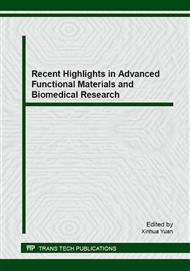[1]
X. H. Yuan, Y. Q. Liu, Z. R. Han, et al. Preparation and performance of self-healing epoxy resin composite with healing agent modified by melt reaction. Journal of Jiangsu University: Natural Science Edition, 2013, 34(2): 217-221.
Google Scholar
[2]
White S R, Sottos N R, Geubelle P H, et al. Autonomic healing of polymer composite. Nature, 2001, 409(2): 794-797.
Google Scholar
[3]
X. H. Yuan, J. W. Xu, Y. Lei, et al. Preparation and adsorption thermodynamics of aminated-hypercrosslinked polymeric adsorbents, Journal of Jiangsu University: Natural Science Edition, 2012, 33(3): 328-332.
Google Scholar
[4]
Rule J D, Brown E N, Sottos N R, et al. Wax-Protected Catalyst Microspheres for Efficient Self-Healing Materials. Advanced Materials, 2005, 17(2): 205-208.
DOI: 10.1002/adma.200400607
Google Scholar
[5]
Rule J D, Sottos N R, White S R. Effect of microcapsule size on the performance of self-healing polymers. Polymer, 2007, 48(12): 3520-3529.
DOI: 10.1016/j.polymer.2007.04.008
Google Scholar
[6]
Zou Y M, Zhang Z, Wu X Y, et al. Hollow fiber supported ionic liquid-liquid micro-extraction for determination of 4-n-Nonylphenol in environmental water samples. Journal of Jiangsu University: Natural Science Edition, 2014, 35(2): 233-237.
DOI: 10.3724/sp.j.1096.2012.20081
Google Scholar
[7]
Blaiszik B J, Caruso M M, Mcllroy D A, et al. Microcapsules filled with reactive solutions for self-healing materials. Polymer, 2009, 50(4): 990-997.
DOI: 10.1016/j.polymer.2008.12.040
Google Scholar
[8]
Yuan L, Liang G Z, Xie J Q, et al. Preparation and characterization of poly(urea-formaldehyde) microcapsules filled with epoxy resins. Polymer, 2006, 47(15): 5338-5349.
DOI: 10.1016/j.polymer.2006.05.051
Google Scholar
[9]
Gao Y H, Lu Y, Han Q, et al. Influence of graphene thin layer on performance of organic light emitting devices. Journal of Jiangsu University: Natural Science Edition, 2014, 35(3): 339-342.
Google Scholar
[10]
Keller M W, White S R, Sottos N R. A self-healing poly(dimethyl siloxane) elastomer. Advanced Functional Materials, 2007, 17(14): 2399-2404.
DOI: 10.1002/adfm.200700086
Google Scholar
[11]
Yin T, Rong M Z, Zhang M Q, et al. Self-healing epoxy composites - Preparation and effect of the healant consisting of microencapsulated epoxy and latent curing agent. Composites Science and Technology, 2007, 67(2): 201-212.
DOI: 10.1016/j.compscitech.2006.07.028
Google Scholar
[12]
Mangun C L, Mader A C, Sottos N R, et al. Self-healing of a high temperature cured epoxy using poly(dimethysiloxane) chemistry. Polymer, 2010, 51(18): 4063-4068.
DOI: 10.1016/j.polymer.2010.06.050
Google Scholar
[13]
Cho S H, Andersson H M, White S R, et al. Polydimethylsiloxane-Based Self-Healing Materials. Advanced Marerials, 2006, 18(8): 997-1000.
DOI: 10.1002/adma.200501814
Google Scholar
[14]
Li Y P, Xu Y, Cheng X N, et al. Preparation of chitosan nanoparticles with fissuaring structure by inverse miniemulsion cross linking method. Journal of Jiangsu University: Natural Science Edition, 2014, 35(1): 120-124.
Google Scholar
[15]
Keller M W, White S R, Sottos N R. Torsion fatigue response of self-healing poly(dimethylsiloxane) elastomers. Polymer, 2008, 49(13-14): 3136-3145.
DOI: 10.1016/j.polymer.2008.04.041
Google Scholar


